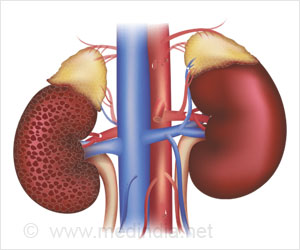Two newer groups of medications prescribed for Type 2 diabetes named SGLT2 inhibitors and GLP-1 receptor agonists could reduce risks associated with chronic kidney disease (CKD) and heart disease.

The composite results of the trials found that SGLT2 inhibitors and GLP-1 RAs can safely and significantly reduce the risk of cardiovascular events and death, reduce hospitalization and slow the progression of chronic to end-stage kidney disease including the risks of dialysis, transplantation or death.
"A collaborative treatment approach among primary care doctors and specialists in diabetes, cardiology and kidney disease that, when indicated, includes treatment with these two classes of medications could add more heart- and kidney disease-free years and greatly extend survival for people with Type 2 diabetes," said chair of the statement writing committee Janani Rangaswami, M.D., FACP, FAHA, associate chair of research in the department of medicine at Einstein Medical Center and associate clinical professor at the Sidney Kimmel College of Thomas Jefferson University, both in Philadelphia.
Chronic kidney disease (CKD) is a common long-term complication of Type 2 diabetes and represents a major public health problem in the U.S. The two leading causes of chronic kidney disease are Type 2 diabetes and hypertension.
There are 26 million people in the U.S. diagnosed with diabetes and an additional 9.45 million are undiagnosed. In the U.S., 108 million (45%) adults have hypertension (130/80 mmHg or higher) or are taking blood pressure medications. An estimated 37 million American adults have kidney disease.
Most patients with end stage kidney disease have Type 2 diabetes, and people with Type 2 diabetes are at increased risk for high blood pressure, cardiovascular disease (CVD) including heart attacks and heart failure, and stroke.
Advertisement
The scientific statement provides detailed, practical guidance for health care professionals to recognize and treat patients who may benefit from SGLT2 inhibitor and GLP-1 RA medications.
Advertisement
The writing group identified two additional patient subgroups who may benefit from SGLT2 inhibitors and GLP-1 RAs: people with heart failure with reduced ejection fraction (HFrEF) with or without Type 2 diabetes; and people with chronic kidney disease who do not have Type 2 diabetes. The writing group anticipates more data emerging to validate the use of SGLT2 inhibitors and GLP-1 RA medications for these at-risk patients.
GLP-1 RAs received initial FDA approval for use in glycemic control in 2005, and SGLT2 inhibitors were approved in 2013, and they were approved for treating people with Type 2 diabetes.
Medications within the two classes work in different ways: SGLT2 inhibitors decrease blood sugar by causing the kidneys to remove sugar from the body through the urine. Research on medicines in this class have shown they also can reduce the risk of heart failure, slow the progression of chronic kidney disease and reduce risk of cardiovascular death.
GLP-1 RAs work by simulating the functions of the body's natural incretin hormones that help lower post-meal blood sugar levels. The medicines in this group have been shown to reduce the risks of heart attack, ischemic stroke and/or cardiovascular death.
Recent studies show these newer medications are not widely prescribed, especially among patients with higher risks for cardiovascular disease and chronic kidney disease. A recent nationwide study of over one million commercially insured and Medicare Advantage adult beneficiaries showed that 7% of patients with Type 2 diabetes were treated with an SGLT2 inhibitor medication.
"Currently in the U.S., primary care professionals or endocrinologists typically initiate the use of these medications in patients with Type 2 diabetes, yet a more multi-specialty approach that includes kidney and heart specialists could help more patients benefit from treatment," noted the statement authors.
"The most important question that needs to be addressed in the future is the actual implementation of these medicines in clinical practice," said Rangaswami.
"When multidisciplinary teams can identify high-risk patients and ensure targeted delivery of these therapies, as appropriate, we could greatly reduce the burden of heart and kidney disease for millions of people with Type 2 diabetes. Improving the cardiovascular and kidney health of as many people as possible - reducing morbidity, mortality and health care expenditures - are the primary goals."
Source-Eurekalert












